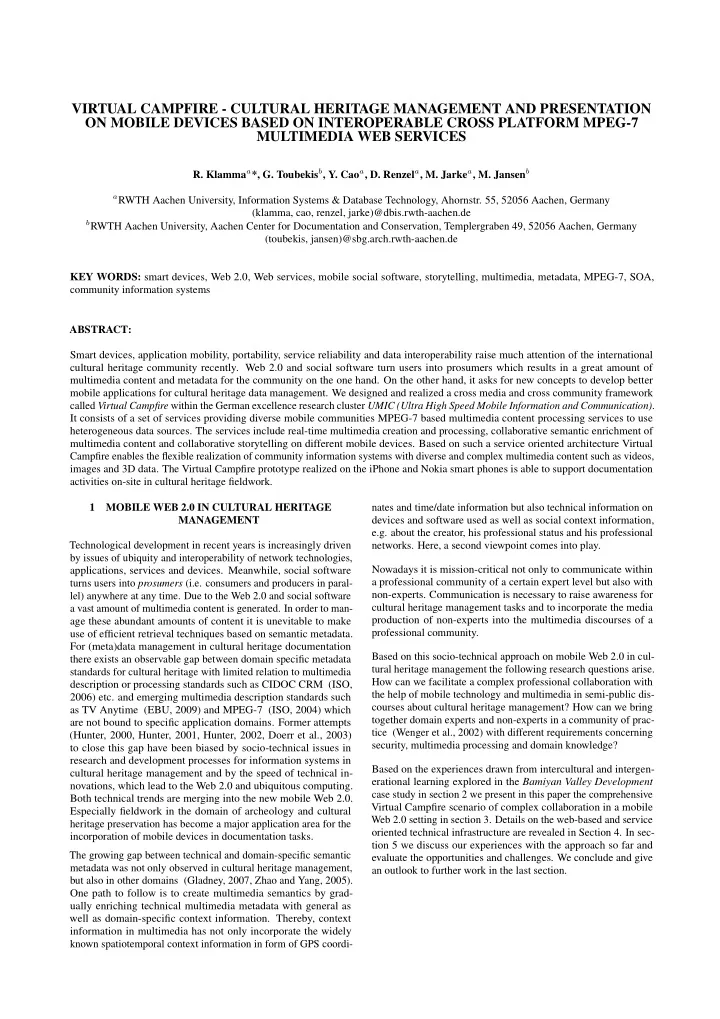

VIRTUAL CAMPFIRE - CULTURAL HERITAGE MANAGEMENT AND PRESENTATION ON MOBILE DEVICES BASED ON INTEROPERABLE CROSS PLATFORM MPEG-7 MULTIMEDIA WEB SERVICES R. Klamma a *, G. Toubekis b , Y. Cao a , D. Renzel a , M. Jarke a , M. Jansen b a RWTH Aachen University, Information Systems & Database Technology, Ahornstr. 55, 52056 Aachen, Germany (klamma, cao, renzel, jarke)@dbis.rwth-aachen.de b RWTH Aachen University, Aachen Center for Documentation and Conservation, Templergraben 49, 52056 Aachen, Germany (toubekis, jansen)@sbg.arch.rwth-aachen.de KEY WORDS: smart devices, Web 2.0, Web services, mobile social software, storytelling, multimedia, metadata, MPEG-7, SOA, community information systems ABSTRACT: Smart devices, application mobility, portability, service reliability and data interoperability raise much attention of the international cultural heritage community recently. Web 2.0 and social software turn users into prosumers which results in a great amount of multimedia content and metadata for the community on the one hand. On the other hand, it asks for new concepts to develop better mobile applications for cultural heritage data management. We designed and realized a cross media and cross community framework called Virtual Campfire within the German excellence research cluster UMIC (Ultra High Speed Mobile Information and Communication) . It consists of a set of services providing diverse mobile communities MPEG-7 based multimedia content processing services to use heterogeneous data sources. The services include real-time multimedia creation and processing, collaborative semantic enrichment of multimedia content and collaborative storytelling on different mobile devices. Based on such a service oriented architecture Virtual Campfire enables the flexible realization of community information systems with diverse and complex multimedia content such as videos, images and 3D data. The Virtual Campfire prototype realized on the iPhone and Nokia smart phones is able to support documentation activities on-site in cultural heritage fieldwork. 1 MOBILE WEB 2.0 IN CULTURAL HERITAGE nates and time/date information but also technical information on MANAGEMENT devices and software used as well as social context information, e.g. about the creator, his professional status and his professional Technological development in recent years is increasingly driven networks. Here, a second viewpoint comes into play. by issues of ubiquity and interoperability of network technologies, Nowadays it is mission-critical not only to communicate within applications, services and devices. Meanwhile, social software a professional community of a certain expert level but also with turns users into prosumers (i.e. consumers and producers in paral- non-experts. Communication is necessary to raise awareness for lel) anywhere at any time. Due to the Web 2.0 and social software cultural heritage management tasks and to incorporate the media a vast amount of multimedia content is generated. In order to man- production of non-experts into the multimedia discourses of a age these abundant amounts of content it is unevitable to make professional community. use of efficient retrieval techniques based on semantic metadata. For (meta)data management in cultural heritage documentation Based on this socio-technical approach on mobile Web 2.0 in cul- there exists an observable gap between domain specific metadata tural heritage management the following research questions arise. standards for cultural heritage with limited relation to multimedia How can we facilitate a complex professional collaboration with description or processing standards such as CIDOC CRM (ISO, the help of mobile technology and multimedia in semi-public dis- 2006) etc. and emerging multimedia description standards such courses about cultural heritage management? How can we bring as TV Anytime (EBU, 2009) and MPEG-7 (ISO, 2004) which together domain experts and non-experts in a community of prac- are not bound to specific application domains. Former attempts tice (Wenger et al., 2002) with different requirements concerning (Hunter, 2000, Hunter, 2001, Hunter, 2002, Doerr et al., 2003) security, multimedia processing and domain knowledge? to close this gap have been biased by socio-technical issues in research and development processes for information systems in Based on the experiences drawn from intercultural and intergen- cultural heritage management and by the speed of technical in- erational learning explored in the Bamiyan Valley Development novations, which lead to the Web 2.0 and ubiquitous computing. case study in section 2 we present in this paper the comprehensive Both technical trends are merging into the new mobile Web 2.0. Virtual Campfire scenario of complex collaboration in a mobile Especially fieldwork in the domain of archeology and cultural Web 2.0 setting in section 3. Details on the web-based and service heritage preservation has become a major application area for the oriented technical infrastructure are revealed in Section 4. In sec- incorporation of mobile devices in documentation tasks. tion 5 we discuss our experiences with the approach so far and The growing gap between technical and domain-specific semantic evaluate the opportunities and challenges. We conclude and give metadata was not only observed in cultural heritage management, an outlook to further work in the last section. but also in other domains (Gladney, 2007, Zhao and Yang, 2005). One path to follow is to create multimedia semantics by grad- ually enriching technical multimedia metadata with general as well as domain-specific context information. Thereby, context information in multimedia has not only incorporate the widely known spatiotemporal context information in form of GPS coordi-
Recommend
More recommend